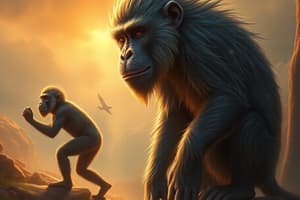Podcast
Questions and Answers
What is the primary basis for clade classification among apes?
What is the primary basis for clade classification among apes?
- Geographical distribution and habitat
- Similar appearance and lifestyle
- Shared derived traits and genetic evidence (correct)
- Overall body size and weight
Which of the following apes is excluded from a grade grouping that includes gorillas, chimpanzees, and bonobos?
Which of the following apes is excluded from a grade grouping that includes gorillas, chimpanzees, and bonobos?
- Gorilla
- Bonobo
- Chimpanzee
- Orangutan (correct)
In contrast to clade classification, what do grade groupings primarily reflect?
In contrast to clade classification, what do grade groupings primarily reflect?
- Genetic differences
- Social behaviors
- Levels of adaptation or overall similarity (correct)
- Evolutionary ancestry
What characteristics lead to the grouping of certain apes in a grade classification?
What characteristics lead to the grouping of certain apes in a grade classification?
Why are humans often considered unusual in comparisons with other apes?
Why are humans often considered unusual in comparisons with other apes?
What is the primary reason many nonprimates have fewer digits than primates?
What is the primary reason many nonprimates have fewer digits than primates?
What is the age of the earliest primate fossils, indicating the appearance of opposable thumbs and toes?
What is the age of the earliest primate fossils, indicating the appearance of opposable thumbs and toes?
Which trait is considered an ancestral characteristic in primates?
Which trait is considered an ancestral characteristic in primates?
How do opposable thumbs and toes aid primates in their environment?
How do opposable thumbs and toes aid primates in their environment?
Which statement about pentadactyly is true regarding primates and nonprimates?
Which statement about pentadactyly is true regarding primates and nonprimates?
Flashcards are hidden until you start studying
Study Notes
Clade vs. Grade
- Clade grouping is based on shared derived traits and genetic evidence, reflecting close evolutionary relationships.
- Grade grouping reflects levels of adaptation or overall similarity, not necessarily evolutionary relationships.
Primate Traits
- Primates have the generalized trait of pentadactyly, possessing five digits on each limb.
- Opposable thumbs and toes are derived traits that appeared in the earliest primate fossils, enabling primates to be excellent climbers and manipulators.
Dietary Types Among Primates
- Frugivores are primarily fruit eaters.
- Insectivores primarily eat insects.
- Folivores primarily eat leaves.
- Gummivores specialize in eating gums and saps.
Locomotor Adaptations
- Vertical clinging and leaping: Primates with this adaptation have longer legs than arms, long fingers and toes, smaller bodies, and elongated ankle bones.
- Quadrupedalism: The most common form of locomotion among primates. Terrestrial quadrupeds have longer arms and legs, often with shorter tails. Arboreal quadrupeds have shorter arms and legs and longer tails.
- Brachiation: A form of locomotion in which primates swing from branch to branch using their arms.
- Bipedalism: Walking on two legs, a form of locomotion unique to humans.
Suborder Strepsirrhini
- Strepsirrhini are a suborder of primates that includes lemurs, lorises, and galagos.
- Strepsirrhines have a number of primitive characteristics, including a wet nose, a tooth comb, and a grooming claw.
Studying That Suits You
Use AI to generate personalized quizzes and flashcards to suit your learning preferences.




